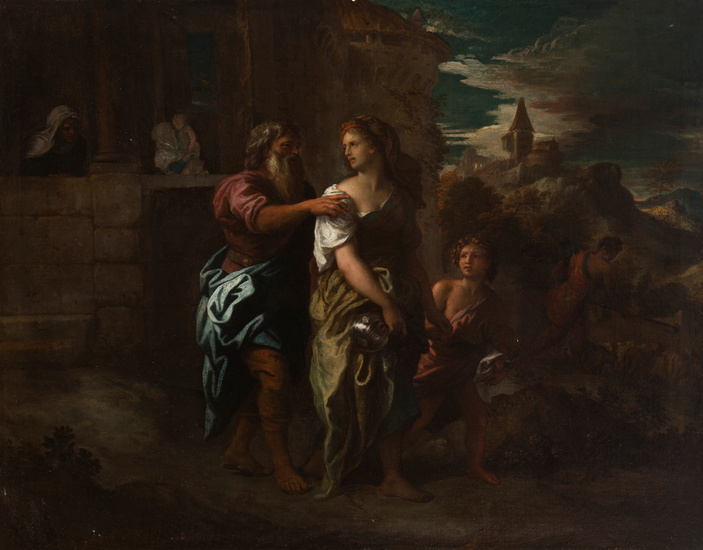French school; end of the XVII century.
French school; end of the 17th century.
"Abraham repudiating Hagar".
Oil on canvas.
Measurements: 82 x 105 cm.
The author of this work collects one of the most dramatic passages of the biblical narrative. The scene represented is taken from the Old Testament; according to the Genesis, although God promised Abraham to be the father of nations, his wife Sara was sterile. To help her husband fulfill his destiny, she offered him her slave Hagar as a concubine. Hagar soon became pregnant, and began to despise her mistress. Sarah complained bitterly to her husband, and he told her to do with the maid as she pleased. Sarah's harsh treatment of Hagar forced her to flee with her son Ishmael, but an angel urged her to return to her mistress. Upon her return, however, Sarah conceives Isaac, and Hagar her son Ishmael. These are driven out of Abraham's house, which is just the moment depicted in this scene. Mother and son then wandered in the wilderness of Beersheba, where they ran out of water. As the child wept, an angel appeared again, telling them that they had been heard by God; he showed them a fountain of water and gave the boy to drink, who would be protected by the Lord since.
This work has an ancient attribution to Nicolas Poussin (Les Andelys, Normandy, 1594-Rome, 1665), in fact the National Gallery of Rome, houses in its collection a late painting by the artist where he treats the same subject. Poussin was the most important painter of the French 17th century and the fundamental master of classicism. He trained in his region of birth with a late-mannerist author and later in Paris. Thanks to his friendship with the poet Giambattista Marino, he traveled to the Italic peninsula and was introduced to the most advanced Roman intellectual circles, while meeting the patrons and protectors of the arts in the Eternal City, where he settled. Poussin's success lies in the rejection of Caravaggism, which was beginning to go out of fashion, and in the adoption of the great examples of the Renaissance, modernized in a tempered baroque classicist sense. An admirer of Giulio Romano, and especially of Raphael, he devoted himself to a pure classicism influenced by Domenichino and other painters of a similar spirit.
HELP
View it on
Sale price
Estimate
Time
Auction House
French school; end of the 17th century.
"Abraham repudiating Hagar".
Oil on canvas.
Measurements: 82 x 105 cm.
The author of this work collects one of the most dramatic passages of the biblical narrative. The scene represented is taken from the Old Testament; according to the Genesis, although God promised Abraham to be the father of nations, his wife Sara was sterile. To help her husband fulfill his destiny, she offered him her slave Hagar as a concubine. Hagar soon became pregnant, and began to despise her mistress. Sarah complained bitterly to her husband, and he told her to do with the maid as she pleased. Sarah's harsh treatment of Hagar forced her to flee with her son Ishmael, but an angel urged her to return to her mistress. Upon her return, however, Sarah conceives Isaac, and Hagar her son Ishmael. These are driven out of Abraham's house, which is just the moment depicted in this scene. Mother and son then wandered in the wilderness of Beersheba, where they ran out of water. As the child wept, an angel appeared again, telling them that they had been heard by God; he showed them a fountain of water and gave the boy to drink, who would be protected by the Lord since.
This work has an ancient attribution to Nicolas Poussin (Les Andelys, Normandy, 1594-Rome, 1665), in fact the National Gallery of Rome, houses in its collection a late painting by the artist where he treats the same subject. Poussin was the most important painter of the French 17th century and the fundamental master of classicism. He trained in his region of birth with a late-mannerist author and later in Paris. Thanks to his friendship with the poet Giambattista Marino, he traveled to the Italic peninsula and was introduced to the most advanced Roman intellectual circles, while meeting the patrons and protectors of the arts in the Eternal City, where he settled. Poussin's success lies in the rejection of Caravaggism, which was beginning to go out of fashion, and in the adoption of the great examples of the Renaissance, modernized in a tempered baroque classicist sense. An admirer of Giulio Romano, and especially of Raphael, he devoted himself to a pure classicism influenced by Domenichino and other painters of a similar spirit.
HELP



